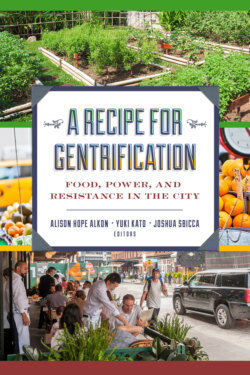Читать книгу A Recipe for Gentrification - Группа авторов - Страница 23
На сайте Литреса книга снята с продажи.
Conclusion
ОглавлениеMany savior entrepreneurs view their hard work as serving to rescue areas from neglect and create an affluent clientele that appreciate the creative and quirky nature of local businesses, though this paves the way for demon developers to profit. The savior entrepreneurs and preservationists in Central Park and similar neighborhoods are also profit-motivated, but their relationship to profit is more complicated. They have clearly benefited from the restaurant-oriented redevelopment of the city, but they espouse a community ethic that they present as oppositional to the profit motive. My findings are similar to Brown-Saracino’s (2009), who points out the different subjectivities of gentrifiers, in particular the “social preservationists” and “homesteaders” who recognize (to varying degrees) the downsides of gentrification. They see themselves as defenders of the values that make Durham special, and they see themselves as under threat from the development process they partially set in motion, yet they also recognize the negative effects of housing and retail gentrification on more marginalized populations. Nevertheless, because they “saved” the neighborhood from neglect, they rarely take personal responsibility for their role in gentrification. Rather, they attribute this negative role to demon developers. This energy was directed politically in the 2017 mayoral and city council elections. The six council seats and mayor are now held by people who all identify as “progressive” and motivated by social justice, and five are people of color.
The savior entrepreneur has a global awareness of social and political issues and highly values inclusion, tolerance, and diversity. It is a socio-spatial community of consumers and producers who have a self-perception of being creative and non-conformist. Their values are informed by global trends that exist alongside consumption that is driven by local loyalty and pride. In the case of Durham, they are conflicted because they share anxiety about the loss of the gritty and alternative identity of the city that gave it its “soul.” In the face of gentrification, urban redevelopment, and the reality of segregated neighborhoods, they find it difficult to live their values of diversity and inclusion. They have a high level of anxiety that businesses are not diverse enough and that “diverse people” (read people of color) people are not participating in the businesses and communities where they live and work.
In gourmet restaurants this comes through most obviously in menus that feature fair, local, and organic foods. But it also comes through in the ways that food writers, chefs, and patrons discuss the role of restaurants and food in the development of the city. One food writer explicitly makes the connections between the urban social problems of the city and the fancy food served in the restaurants of the boutique hotel, The Durham:
If a hotel is a transitory space where people never stay too long, the true challenge of its restaurant is not winning over guests but locals. Against a veil of socioeconomic concerns about gentrification and strata of race, class and privilege in the city, The Durham’s restaurants are at least standing on their own merits, attempting to welcome locals with food that doesn’t clash so much with its surroundings.
The author raises a central problem: They wish to continue to produce and consume this high-status food, but how can they feel okay about that when they are surrounded by a city that is plagued by inequalities? Despite the awareness of social problems, savior entrepreneurs give limited voice to how their own actions cause retail or residential gentrification. When asked if the bars and restaurants in Durham were becoming pretentious, one business owner said: “I can see how someone might say that but they kind of just don’t get it. I know that sounds bad! But, we’re trying to be creative and put our spin on things.” While the awareness and anxiety about residential and retail gentrification is forefront in many minds, understanding how the spread of gourmet restaurants and bars is contributing to the problem of racial and income exclusion is rarely discussed. And, as much as concern is expressed, gourmet restaurants with $25 entrees continue to populate Durham.
